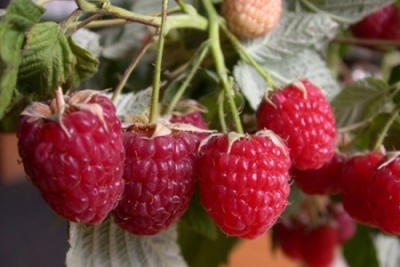
- Authors: NIISS named after M.A. Lisavenko, Sokolova V.A., Kalinina I.P., Kantor T.S.
- Berry color: bright red
- Taste: sweet and sour
- Ripening period: mid-early
- Berry weight, g: 2,9-4,7
- Yield: up to 12.7 t / ha
- Frost resistance: high
- Tasting assessment: 4,2
- Appointment: universal
- Fruiting period: from 8 - 10 July to 1 - 3 August
To be guided by very old varieties of berry plants, as well as completely new ones, is not too correct. It is better to pay attention, for a start, to the varieties that have already been tested by life, but not yet outdated. And one of these options is a raspberry bell.
Breeding history of the variety
The plant was created at the M.A. The work on the project was carried out by breeders Sokolova, Kantor and Kalinina. The selection method was free pollination of the Karnaval variety. The bell was brought out in 1982. This type of raspberry was appreciated not only in Russia, but also abroad.
Description of the variety
The Bell bush is distinguished by its medium spreading. The height of the raspberry is 1.5-2 m. The shoots are distinguished by their straight growth and elasticity. Characteristic purple spots are noted. The leaves are light green in color, medium and large in size, there are very few thorns.
Ripening terms
With this, the situation is as follows:
- the number of fees per season - from 5 to 7;
- mid-term development;
- the approximate fruiting period is from 8 July to 3 August (however, the weather may shift it).
Growing regions
You can cultivate the Bell in:
- Middle Volga region;
- Western Siberia;
- other regions with long cold winters.
Yield
When growing such raspberries on extensive plantations, the harvest can reach 12,700 kg per 1 ha. A single bush will yield 2-8 kg of berries per year. The exact amount depends on the growing conditions and the correct farming technique.
Berries and their taste
The bell produces rich red fruits. They differ in conical shape. The mass of a single berry is from 2.9 to 4.7 g. The juicy pulp has a pleasant, original sweet and sour taste. An expressive powerful aroma is also noted.

Growing features
You can count on fruiting in the second year after planting. Excellent resistance to adverse weather conditions is guaranteed. The plant is also able to resist aggressive pests and infections. Fungal infections and purpuric spotting are, alas, probable, albeit marginally. Raspberry Bellflower can be affected by spider mites.
The variety is self-fertile, and you can even limit yourself to a single bush.
Site selection and soil preparation
The variety needs solid lighting, good protection from drafts. It is unacceptable to choose areas with a high location of soil waters. It is also strictly forbidden to grow such raspberries in the lowlands, where a lot of melt or rainwater collects. Raspberry trees should not be planted near fences, sheds and other buildings. There should be no weeds in the ground, but fertilizers must be applied.
Other recommendations:
- raspberries should be planted either in early April or in the first half of October (so that there is still a fair amount of time left before frost);
- holes or trenches are prepared in advance, their depth is 0.4 m, the width is the same;
- landing is done in order, by the belt method;
- it is useful to orient the rows along the east-west axis.


Pruning
Leaves should be cut off if they thicken too much. This can be done with the most common pruning shears. The stems are pruned after the end of fruiting. You need to retreat from the ground by 6-8 cm. Annual shoots in large quantities are not needed - you only need to leave 4-6 pieces per 1 bush.

Watering and feeding
Waterlogging for a raspberry bell is no less dangerous than drying out. During the season, 5-7 waterings are usually carried out. The land should be soaked by 0.2-0.4 m. Water consumption per 1 sq. M. m of raspberry planting is 30-40 liters. Other recommendations:
- in the first year, feeding is not needed;
- in the spring, rotted manure is laid - from 5 to 6 kg per 1 sq. m;
- in the summer, 0.04-0.05 kg of urea, 0.2-0.25 kg of superphosphate, 0.06-0.07 kg of potassium sulfate are laid on 1 m2;
- be sure to carry out autumn feeding.




Unfortunately, raspberries, like other plants, do not bypass various diseases and pests. Only by armed with the knowledge and the necessary means for this, you can cope with such troubles. To help the plant, it is very important to be able to recognize the disease in time and begin timely treatment.
Reproduction
It is necessary to breed this variety first of all vegetatively. Seed propagation is justified only for breeding work. In usual dacha practice, bushes are often cut or divided. All possible types of cuttings are suitable for work, but the root version manifests itself best.
The length of the roots harvested for planting in the fall should be 5-10 cm. Their thickness is from 0.5 to 1.5 cm. The harvested planting material is kept dug in the sand in a cool room throughout the winter. In order not to risk once again with planting in open ground, preliminary germination in greenhouses is recommended. Having landed on a permanent place the established specimens, you can insure yourself against troubles.








































































